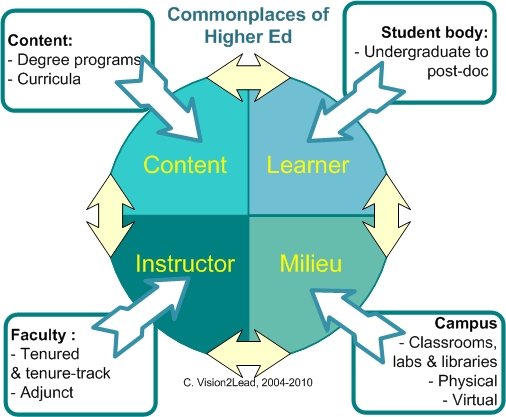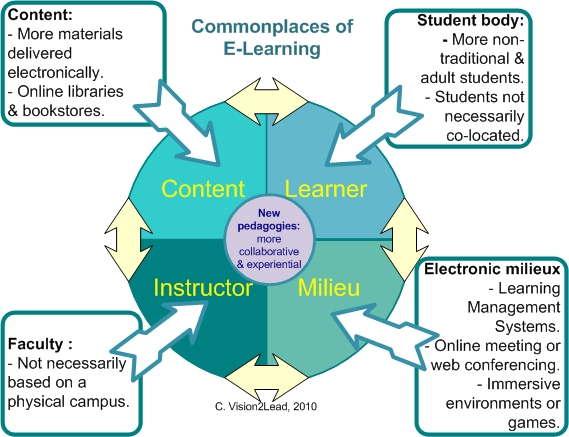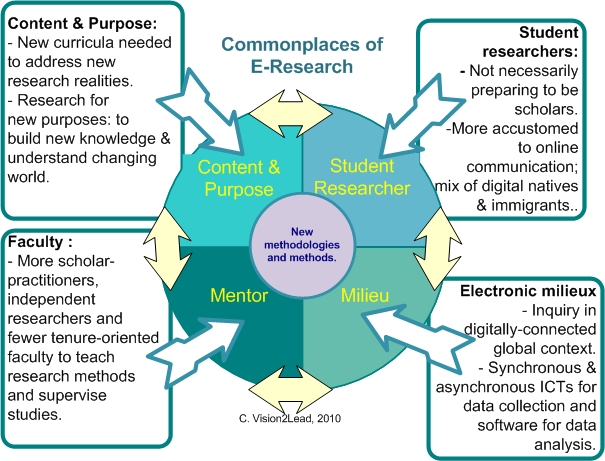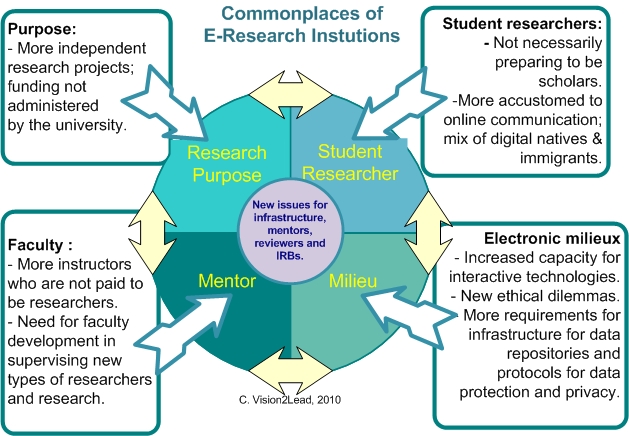Key Takeaways
- Joseph Schwab’s four commonplaces — learner, instructor, content, and milieu — provide a conceptual framework for thinking about higher education’s multidimensional systems.
- Changes in any sector ripple through the others to influence the whole infrastructure of commonplaces, thus all must be accounted for in IT and general planning.
- Shifts in the commonplaces caused by e-learning will be reflected in new changes when faculty and students move toward e-research.
- Collaborative thinking is needed to create uncommon places for e-research as developing trends force new directions.
A discussion of higher education and its future could refer to many things:
- Academia as a whole;
- The specific institution as a place where research, teaching, and learning occur; or
- The research and learning processes that create new knowledge and new meaning.
They are all interconnected: higher education is a set of interlocking systems, from the institutional system to the classroom system. Changes to any one part eventually ripple through to influence the whole — including the "who, where, and why" involved in research. Technology infrastructure choices influence the other systems, and at the same time, new directions in instruction and research affect the needs of individuals and groups for various kinds of information and communications technology (ICT) tools.
Systems and Commonplaces in Higher Education
Joseph Schwab identified four commonplaces — learner, instructor, content, and milieu — that provide a conceptual framework for thinking about higher education’s multidimensional systems.1 We can use the terminology of these commonplaces together with the relationships among the terms shown in Figure1 to describe how changes in one dimension of higher education relate to changes in the others.

Figure 1. Commonplaces of Higher Education
For example, at the institutional level, changes to a degree program influence the instructional settings required for courses, the faculty needed to teach, and the characteristics of students the program attracts. At the classroom level, changes in the role or teaching style of the instructor, course content and learning materials, student characteristics, and classroom environment shape the nature and meaning of the learning experience.
ICTs Keep Making Waves
We see ripples through the whole system when new factors arise. Since ICTs were introduced to higher education, we have seen tidal waves. Technology in all its forms has changed how we teach and learn, write, publish, access, and use content; the kinds of milieux where learning experiences occur; and how, where, and when we conduct e-research.
When technology reanimated old ideas about distance learning, the resulting e-learning phenomena changed not only the delivery of learning content from face-to-face to online but also the pedagogy (from lecture-based to more collaborative and exploratory teaching and learning), characteristics of students (by including more nontraditional and adult students), and institutions (by introducing new programs and whole new types of colleges and universities offering degrees to students across the globe). This cascade of change resulted, in turn, in new needs for online student services, advising, libraries, bookstores, and so forth.2
Electronic production and delivery of documents, journals, and publications is changing the types of readings used in classes and, as a result, is transforming entire industries based in print publishing. The kinds of electronic infrastructure needed to enable online teaching and learning have created whole new career fields in instructional technology and instructional design.
The option for faculty to teach without being present on a physical campus — combined with other funding and budgetary issues — has contributed to another trend: colleges and universities are moving toward lecturers and adjuncts and away from traditional full-time faculty professors. The New York Times recently reported numbers the American Association of University Professors and others have noted: only 27 percent of college professors in the United States are tenured or on a tenure track, as compared with 75 percent in 1960.3 This trend is likely to increase in the next decade as tenured faculty retire and their jobs are replaced with other kinds of instructional positions. With more pressure on colleges and universities to develop students’ career-oriented competencies, the concept of a professor as a "scholar-practitioner" with both real-world professional experience and academic credentials is gaining acceptance. Certainly not all of the non-tenure-track faculty are online instructors, but online instruction is particularly attractive to faculty members with other professional responsibilities.
Given that one in four college students took an online course in 2009, a 17 percent increase over the number reported the previous year, it would seem that the e-learning "commonplaces" are becoming, well, common.4 E-learning has changed the places where instruction occurs (see Figure 2).

Figure 2. Commonplaces of E-Learning
E-Research Is Next
Clearly, the entire domain of teaching and learning is in the midst of a sea change. What next? I believe that research and scholarship will be the next areas to feel shifts comparable to those that have occurred with the move from classroom teaching to e-learning. How will the nature of scholarly inquiry — the questions asked, the characteristics of the researcher, and the instructional, institutional, and infrastructure systems that support research — change as technology becomes yet more widely adopted? How will these changes affect the ways in which research is taught, conducted, and supervised? Since my interest is in qualitative research, I will leave changes to experimental research and lab science to other forecasters.
The framework of commonplaces can again be adapted in contemplating a move toward e-research. Notice that, in Figure 3, "Purpose" has been added to the upper-left quadrant, while "Mentor" replaces "Instructor" in the lower-left quadrant. "Purpose" applies to the research purpose. "Mentor" is intended to include roles like the chair of a dissertation committee.

Figure 3. Commonplaces of E-Research
Questions about potential changes to the e-research system can start with the faculty role, taking into account potential implications of the statistic noted above: 73 percent of faculty are not in tenure-track or tenured positions. Consider this fundamental point: the new faculty members are most likely not publishing in academic journals or doing empirical research as a part of their jobs as adjuncts or lecturers. If these faculty members are conducting research, it is most likely as independent scholars. In other words, they are operating outside of the traditional support systems for academic scholarship. If indeed these circumstances result in a shift of research away from academic institutions, it might have an impact on funding streams from research grants. Since institutions have, in the past, counted on such funding, the shift might have systemic economic repercussions.
Independent researchers might be more likely to choose online research over more costly alternatives for collecting data. E-research could transition away from a world of higher education where scholars who conduct research within academic institutions train new scholars to do the same. In the emerging new higher education, independent scholars and scholar-practitioners could cultivate a next generation of independent scholars and scholar-practitioners to function in a broader world that extends beyond academic institutions (see Figure 4). New technologies for both instruction and research could be a key to this new higher education. Such a shift raises questions for thought, discussion and, yes, research.

Figure 4. Commonplaces of E-Research Institutions
Looking at trends and questions related to professorial roles another way, are the reported more than 73 percent of faculty who are non-tenure-oriented also less experienced as researchers and therefore out of touch with emerging e-research methods? Will they be able to evaluate proposals and supervise e-research adequately? Do such faculty members have the knowledge, skills, and abilities to guide e-researcher students? Clearly, more work is needed to determine standards and criteria for excellence, ethics, and integrity in e- research.
On the student side of the system, graduate students learning to conduct research are well aware of the shifts in academia. They can see that the traditional route to a scholarly academic vocation may be highly competitive or simply not an option. At the same time, today’s students are accustomed to communicating electronically. While some are digital natives born with buds in their ears, others are immigrant adult learners who have adopted new technologies to take advantage of opportunities for career or personal growth, including online learning. In either case, when 21st century student researchers think about collecting data through interviews, observations, or participant observations, they will look at ways to explore the digitally connected world they live in, using the tools they are accustomed to using for communication and learning. They will also want to use interactive ICTs to work collaboratively with fellow researchers, share data, and report findings. ICTs conducive to e-research can include text-based as well as multimedia meeting and videoconferencing technology, immersive 3D environments, or new technologies yet to be developed.5
It seems likely that these trends will only accelerate. A central question here is, does the fact that students know how to use ICTs for social communication mean they know how to use them for disciplined, precise, ethical, empirical research? What preparation and guidance do they need from faculty who teach research methods and supervise their studies? And what new lenses will reviewers, institutional review boards, and others need to assess the scholarship and viability of students’ proposals? Referring again to the commonplaces: to serve student researchers who conduct studies in an electronic milieu, institutions may need to commit to new criteria and standards, new course content, and new ways of teaching — and deliver the necessary faculty development.
Creating Uncommon Places for Research
How can institutions of higher education prepare to support e-research? Clearly institutions need to plan for the technical infrastructure that can support a wide variety of research projects across disciplines. As new approaches emerge, we may see further differentiations in the needs of researchers across disciplines, while at the same time campus-wide continuity and interoperability between platforms and software packages might be essential. As the e-learning example shows, however, implications for a shift toward e-research extend far beyond ICT infrastructure and tools. It is not enough to buy or subscribe to the kinds of meeting and videoconference software researchers will need to conduct research interviews and to develop secure repositories for data.
Along with the change in milieu represented by a shift toward more online research, the content (purpose of research), learner (student researcher), and instructor (mentor, supervisor, and reviewer) commonplaces will change. These changes to the academic world will be embedded in larger trends that involve new modes of funding research as well as new understandings and competencies needed by thought leaders in a changing world. Students will expect learning to become a life-long process that complements the changing demands of their careers, whether in academia or in other fields of practice.
Plans being made now for the future must take into account all of the commonplaces. The ways changes in one commonplace reverberate throughout the entire multi-leveled system we call higher education affect us all. Faculty and student researchers, technologists, and others in higher education who care about new scholarship must think collaboratively to create uncommon places for e-research.
- Joseph Schwab, "The Practical 4: Something for Curriculum Professors to Do," Curriculum Inquiry, vol. 13, no. 3 (1983), pp. 240–265.
- Janet E. Salmons, "E-Social Constructivism and Collaborative E-Learning," in Handbook of Research on Electronic Collaboration and Organizational Synergy (Vol. II), Janet E. Salmons and Lynn A. Wilson, eds. (Hershey, PA: Information Science Reference, 2009).
- See "Conversion of Appointments to the Tenure Track (2009)," draft report approved for publication by the Committee on Contingent Faculty and the Profession, American Association of University Professors (AAUP), December 2009 ; and Samantha Stainburn, "The Case of the Vanishing Full-Time Professor," New York Times, December 30, 2009.
- I. Elaine Allen and Jeff Seaman, "Learning on Demand: Online Education in the United States, 2009," Sloan Consortium, January 2010.
- Janet E. Salmons, Online Interviews in Real Time (Thousand Oaks, CA: Sage Publications, (2010).
© 2010 Janet Salmons. The text of this article is licensed under the Creative Commons Attribution-Noncommercial-Share Alike 3.0 license.
